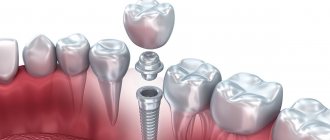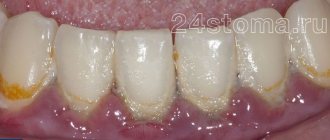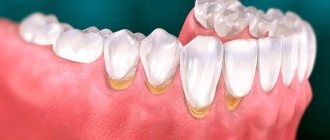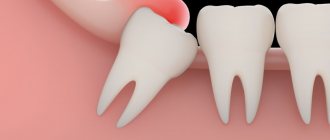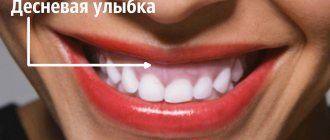Causes Symptoms Treatment Possible complications Prevention
Gum hyperplasia is a condition in which tissue begins to grow excessively. They hang over the teeth, forming false pockets, covering most of them, interfering with hygiene procedures. There are several terms in the literature that describe this condition: gingival overgrowth, hypertrophy, or hypertrophic gingivitis.
The main danger of tissue proliferation is that it promotes the proliferation of bacteria, causing serious diseases such as periodontitis.
What is gum grafting?
Gum grafting is performed in a dental office under local anesthesia. It uses both traditional scalpels and laser technologies. The doctor decides what is suitable in your particular case. Often, in order to get a general idea of the result of the procedure, before it begins, the dentist draws the contours of the future position of the gums on the teeth.
The operation is performed by a periodontist. Before deciding on a procedure, carefully select an aesthetic dentistry clinic and find out the competence of your doctor: ask him about his experience and qualifications. Always look into your dentist's continuing education and ask to see examples of work they have already done.
Recovery phase and care
The doctor schedules a follow-up examination 2–3 days after the removal of the wisdom tooth hood at the dental clinic. During the operation, swelling, pain, and redness may appear. These phenomena gradually disappear after a few days. Prevention of complications is an important step after any operation. After excision of the wisdom tooth hood, the doctor prescribes various medications and procedures:
- Rinse solutions with antiseptics;
- Anti-inflammatory gels and ointments;
- Antibiotics to relieve inflammatory processes;
- Analgesics to relieve pain after surgery;
- Rinse with warm infusion of chamomile, calendula, yarrow.
Food and rinses should be warm. After surgery, in the first period you should not eat hot, cold, spicy, or sour foods. When brushing your teeth every day, you should avoid touching the operated part of your gums. Care and rehabilitation includes equally important points:
- You should not eat anything for several hours after surgery;
- Chew food carefully, try to eat with the opposite side;
- Switch to a diet that includes soft and warm foods;
- Quit smoking, alcohol, avoid exercise and exercise.
The doctor will advise the optimal regimen in the postoperative period, prescribe treatment and the day of the follow-up examination. If you follow the doctor’s recommendations, the risks of complications in the postoperative period are reduced, and the wound heals within 5 to 7 days. Call us and make an appointment for wisdom tooth hood removal in Moscow on our official website. The dental surgeon at our clinic accepts appointments by appointment. We provide services to eliminate any dental problems at low prices and provide emergency dental care in the most severe and urgent cases.
Plastic surgery for gum recession
There are some periodontal diseases that cause gum recession. This is a condition in which the gum tissue shrinks and exposes the root of the tooth, which not only looks unsightly, but can also lead to many problems and even tooth loss. Recession can occur on one tooth or on several.
A too short and powerful frenulum or insufficient vestibule of the oral cavity, as well as some periodontal diseases, contribute to the detachment of the free edge of the gums, the formation of gum pockets, and inflammation. Vestibuloplasty can avoid this. This operation is performed in the vestibule of the oral cavity to deepen it and more rationally distribute soft tissue in this area.
In order to return the gum tissue to the required volume, cover exposed roots, prevent root caries and generally improve the aesthetics of a smile, gum augmentation is also performed. Depending on the situation, only connective tissue and epithelium can be built up, or maybe together with the periosteum. In the first case, such a flap is called split, in the second - complete.
Indications for adjustments
- reduction in the volume of gingival tissue, resulting in exposure of the root tips;
- shortened teeth;
- unequal gum size;
- the presence of large gum pockets and their peeling from the surface of the dental unit;
- an inflammatory process that results in swelling and soreness of the soft tissues.
Contraindications:
- the presence of diabetes mellitus in the patient;
- period of reduced blood clotting;
- weak immunity;
- acute infectious diseases;
- cardiovascular diseases;
- patient intolerance to the anesthetic substance.
Gum extension techniques
There are two main methods of gingivoplasty:
- flap plastic surgery – tissue from the patient’s oral cavity is used. The doctor incises a section of the gum and, using a tissue flap from other areas of the mucous membrane (adjacent gum, palate, inner part of the cheek), forms a contour,
- extension with collagen matrices or barrier membranes - the material is tightly sewn to the area of the gum that needs to be restored, and then the body forms its own tissues based on the material.
The procedure for plastic correction
With any type of surgical intervention, the technology remains unchanged and consists of the following stages:
- examination of the general condition of the gums, preparation of the oral cavity for surgery: elimination of caries, plaque, tartar;
- injection of an anesthetic;
- removing or cutting part of the gum using a scalpel or laser. If there is a shortage of gum tissue, it is transplanted from another place;
- suturing.
After the procedure, the doctor prescribes further treatment and indicates recommendations that should be followed.
Gum plastic surgery during implantation
Gumplasty is performed when the root is exposed, after tooth implantation. Often the need for this operation arises when an implant is installed in place of a long-missing tooth. In this case, the correct gum line is not only aesthetic. It protects the implant from infection and the development of peri-implantitis, which without proper treatment can lead to the loss of the entire structure. In addition, it allows you to prevent further exposure of the roots, reduce tooth hypersensitivity, reduce the likelihood of root destruction and, of course, improve the aesthetics of your smile.
The main causes of pathology
There are a number of main reasons why a tooth can become overgrown with soft tissue. The most common reason is negligence towards periodontal tissues, refusal to visit the clinic after breaking off part of the crown. There are also quite often cases when a wisdom tooth that has not fully erupted is covered with gum on top. In the future, this figure eight can exert strong pressure on the entire dentition, which will lead to a gradual change in the bite and the appearance of serious orthodontic pathologies.
The patient may also encounter a similar situation when refusing to remove the root system of a broken tooth. As a result, a small piece of the top, as well as the root, remains under the gum, and over time they can begin to hurt and become inflamed.
It is important to note that a person’s bad habits, poor diet, consumption of junk food, chronic diseases and lack of oral hygiene can lead to teeth becoming more sensitive and brittle. As a result, the slightest pressure will be enough to cause part of the crown to break off.
Gum grafting against “gummy” and “shark” smiles
The gingival contour depends on many factors. Genetics, certain medications, and certain diseases lead to soft tissue hypertrophy. There are too many of them, which is why the teeth appear small, the so-called “shark smile” appears. In this case, gingivectomy is used. It consists of excision of excess tissue, elimination of gum pockets or hood, which occurs, for example, during the eruption of “wisdom teeth”. After excision of excess, the desired soft tissue contour is formed.
Many patients also resort to gum grafting, especially on the front teeth, if they have a gummy smile. It is characterized by the exposure of more than two millimeters of the upper gum when a person smiles, which gives the face a “horse” appearance. In this case, with the help of gum plastic surgery, excess soft tissue is removed from the surface of the teeth, and the gum contour is given a beautiful shape.
Symptoms
The growth of the mucous membrane is a gradual process. There are 3 degrees:
- The gingival papillae increase in volume. The gingival contour is disrupted and hangs over the tooth.
- The growth progresses, the tissue covers up to half of the coronal part. Bleeding and discomfort when brushing teeth and eating food develop.
- The gum covers the tooth by two thirds, sometimes completely. Folds form in which microflora accumulate, causing inflammation.
The process is generalized
when the entire gum on the jaw suffers.
Focal
hyperplasia is located around one or more teeth.
The edematous form is characterized by the presence of plaque, there is a lot of it, it is quite soft, but covers the enamel with a thick layer. Gum pockets form. The papillae turn red and bleed when pressed.
Patients complain of itching, discomfort in the mouth while eating, and an unpleasant odor.
With fibrous gingival hyperplasia, patients are only concerned about the unusual appearance of the mucous membrane. There is usually no pain or bleeding, but there are complaints of an unpleasant odor.
Gum grafting: healing after surgery
Depending on the type of gum grafting, complete recovery takes from several days to several weeks. Your doctor will give you a list of recommendations to follow after surgery. He will also prescribe painkillers. In general, the recommendations boil down to the following: it is necessary to remain calm and reduce physical activity, eat soft foods at room temperature and avoid spicy foods until the gums are completely restored, and carefully carry out oral hygiene, including rinsing. Until complete healing, you will have to wear a special mouthguard that protects the affected areas from external factors and promotes faster and safer healing.
Swelling after surgery lasts for several days. As a rule, on the third day the swelling may increase, and then subside. If swelling does not go away, severe pain, bleeding or other frightening symptoms appear, you should immediately consult a doctor.
Gum grafting is a surgical procedure, and like any other, it has certain risks. The most common are allergies to the anesthetic and recurrent gum recession. In order to avoid allergies, you should notify your doctor in detail in advance about the presence of any diseases and the occurrence of allergies to medications in the past. In case of relapse, the procedure can be repeated no earlier than six months after the previous one.
Possible complications
Ignoring the disease or medical error can lead to the following complications:
- increase in body temperature up to 38 degrees;
- facial asymmetry due to severe swelling;
- pain that does not disappear even after taking painkillers;
- bleeding the day after the procedure;
- flux.
All these complications indicate a growing inflammatory process not only in the oral cavity, but throughout the body.
It is important to know! Penetration of infection into the circulatory system is very dangerous!
Consequences
If the root and part of the tooth are left inside the gum tissue, some complications may occur. Inflammation in the pulp chamber can begin as a result of dirt and infection; this process is accompanied by severe pain, the appearance of purulent discharge, rotting, etc. To avoid sepsis, surgical removal of the root and nerve endings is recommended.
Another dangerous disease is periodontitis. In the absence of timely treatment, the unit can become very loose; it is surrounded by voids where germs, food particles, and infection can get in. In this case, the root moves away from the coronal part quite quickly and it becomes almost impossible to save it. If the problem is not corrected in time, there is a high risk of damage to other organs and even blood poisoning. The latter threatens with very serious complications and is dangerous to human health.
Another common occurrence is when a previously filled tooth breaks and particles of the composite get into the hole. These particles can react with tissues, which leads to the development of inflammation. In this case, not only the root of our broken tooth can become inflamed, but also nearby units. If inflammation is left unattended by a specialist for a long period of time, a cyst may appear.
Miller classification
Today, the generally accepted classification of gum recession is the Miller classification, which is divided into 4 classes
.
First and second classes
according to Miller - root closure is 100 percent possible.
Third class
according to Miller, 100 percent root closure is impossible.
And fourth grade
according to Miller, he is not even being treated.
What treatments are available for each stage of gum recession?
For the first, second and third classes according to Miller - only surgical closure of the exposed necks of the roots of the teeth. The fourth class according to Miller is not treatable, that is, it cannot be treated.
Is there an age limit for treating gum recession?
No.
There is no age limit for treating gum recession.
How is the operation performed?
- Anesthesia Local anesthesia is used, which eliminates any discomfort. At the request of patients, the procedure can be performed under sedation.
- Operation Excision of excess gum according to the selected protocol, cleansing periodontal pockets of hard deposits and dental plaques.
- Antiseptic treatment Disinfection of the surgical area by repeated rinsing with antiseptics, applying a periodontal bandage.
The use of sedation ensures complete physical and emotional comfort for the patient during the procedure.
After surgery, the gums heal quickly. But in order to avoid complications, we ask you to strictly follow the doctor’s home care instructions.
Features of wisdom tooth eruption
Wisdom teeth or third molars, also known as figure eights, are the outermost teeth in a row, located at the edges of each jaw. There are four of them in total, but often not all of them erupt, and sometimes they may not grow at all.
This will not affect the chewing functions of the jaw, and if you do not have a single eight, there is no need to sound the alarm.
The eruption of third molars is possible at any age, even after 30 years; the patient’s age does not affect the course of the process. But the direction of growth, the presence of free space in a row, the structural features of the jaw can significantly influence the process - will it be painful or will it go unnoticed, will there be a health hazard and will the growth provoke the development of inflammation.
